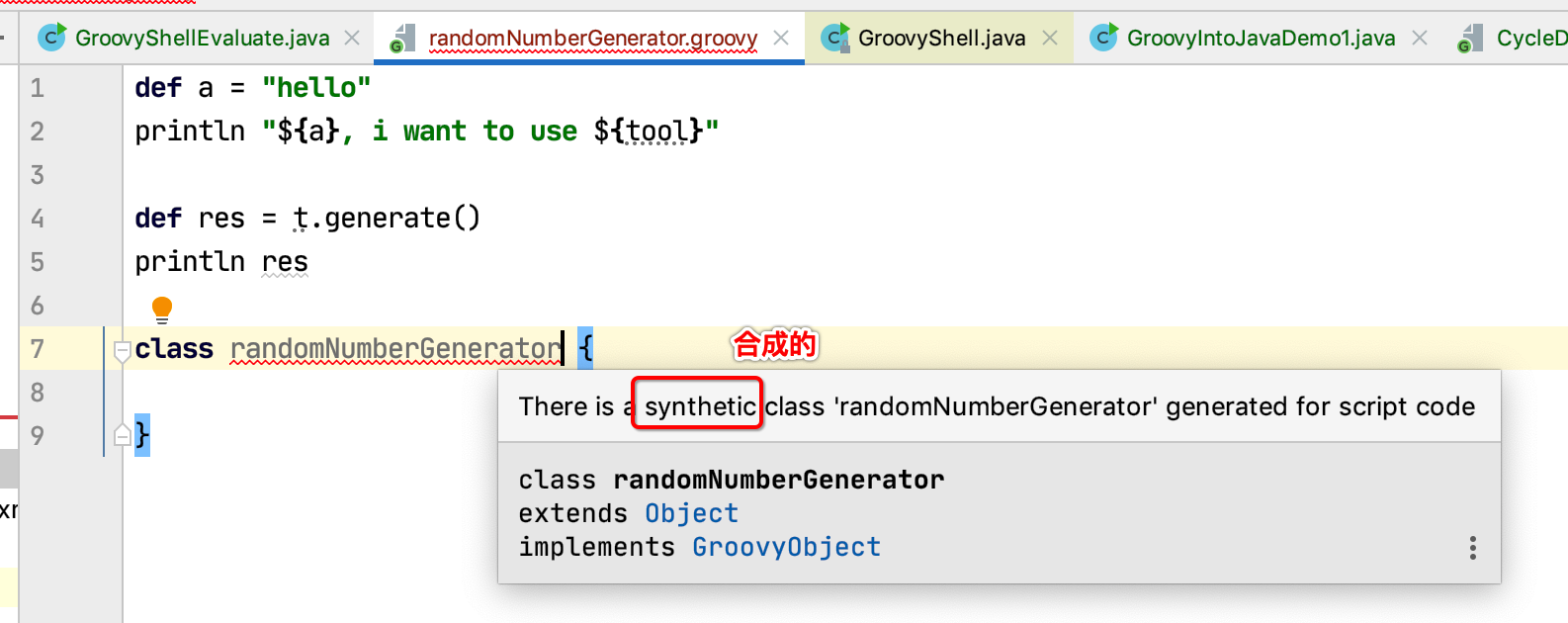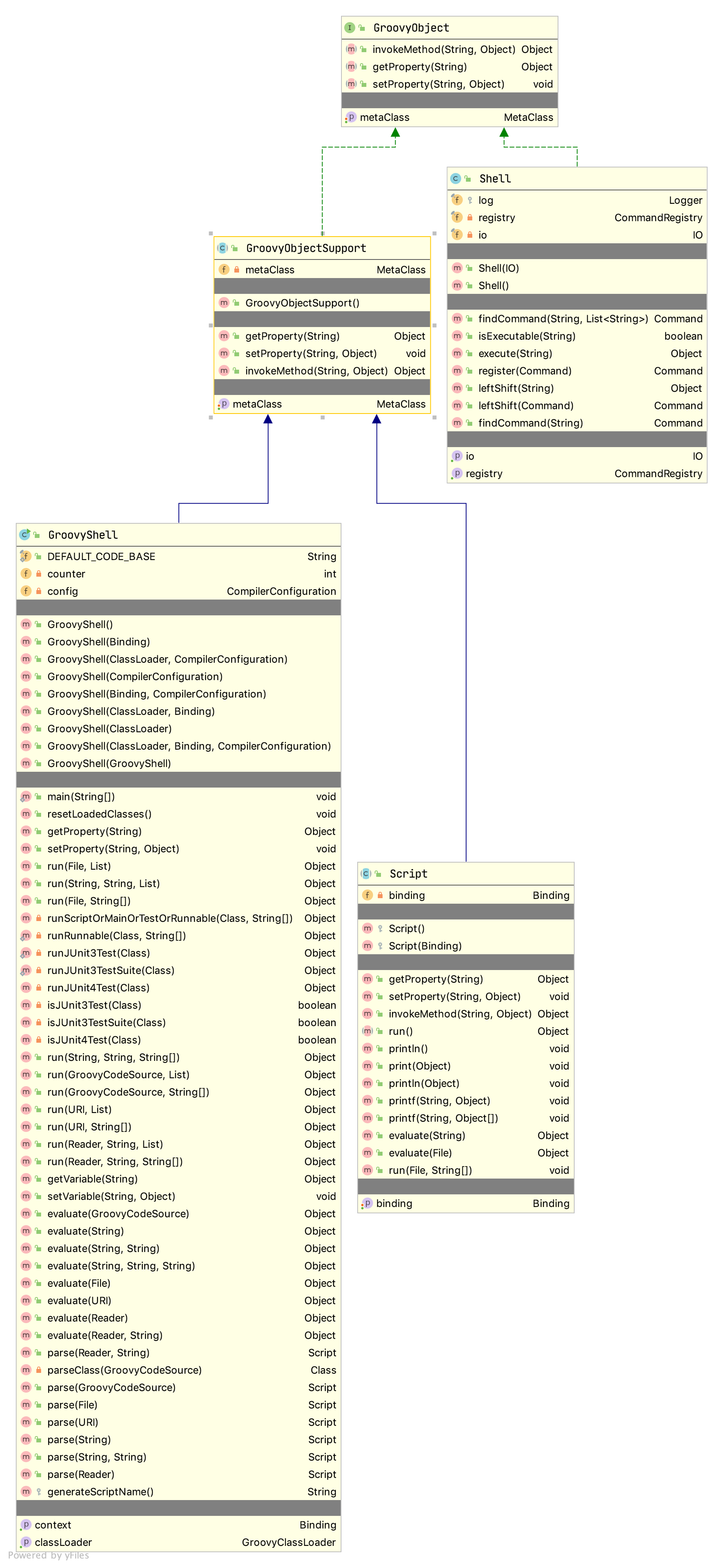参照:https://juejin.cn/post/6954350461818421278#heading-1
1. 编写 Groovy 逻辑的两种风格
- 脚本(不定义和.groovy文件同名的class)
- 类(定义class,所有代码都在class里)
在 .groovy 文件内,可以不声明任何类而直接在文件顶级层次编写代码逻辑 (笔者刚才就是这样做的)。不过这样的话,就不能在文件的顶级层次再声明一个和文件同名的类,否则编译器会给出 there is a synthetic class generated for script code 的错误。从编译角度来看这可以理解,因为 .groovy 文件被编译成 .class 文件并执行时,编译器实际上会为其生成一个合成类,而正是这一步导致了冲突发生:我们刚定义的类名和它重复了。
.groovy 文件内部出现了和文件同名的类,则意味着这个 .groovy 文件会被视作是一段 "用 Groovy 方言编写的 Java 代码",一般它也就不再作为脚本使用,而是变成一个 "普通的类" ( IDEA 称它是一个 Groovy Class) 。这么做的一个直接后果是,我们不能够在文件的顶级层次直接编写代码逻辑。
2. Java集成groovy之GroovyShell、GroovyScriptEngine、GroovyClassLoader
https://www.cnblogs.com/jsersudo/p/10178407.html
- GroovyClassLoader
用 Groovy 的 GroovyClassLoader ,动态地加载一个脚本并执行它的行为。GroovyClassLoader是一个定制的类装载器,
负责解释加载Java类中用到的Groovy类。
- GroovyShell
GroovyShell允许在Java类中(甚至Groovy类)求任意Groovy表达式的值。您可使用Binding对象输入参数给表达式,
并最终通过GroovyShell返回Groovy表达式的计算结果。
- GroovyScriptEngine
GroovyShell多用于推求对立的脚本或表达式,如果换成相互关联的多个脚本,使用GroovyScriptEngine会更好些。
GroovyScriptEngine从您指定的位置(文件系统,URL,数据库,等等)加载Groovy脚本,并且随着脚本变化而重新加载它们。
如同GroovyShell一样,GroovyScriptEngine也允许您传入参数值,并能返回脚本的值。
1 package groovy; 2 3 import groovy.lang.*; 4 import groovy.util.GroovyScriptEngine; 5 import groovy.util.ResourceException; 6 import groovy.util.ScriptException; 7 8 import java.io.File; 9 import java.io.IOException; 10 11 public class GroovyIntoJavaDemo1 { 12 //测试次数 13 private static final int num = 10000; 14 15 public static void main(String[] args) throws IOException, ResourceException, ScriptException { 16 17 /* 18 GroovyClassLoader 19 */ 20 GroovyClassLoader loader = new GroovyClassLoader(); 21 Class aClass = loader.parseClass(new File("src/main/java/groovy/CycleDemo.groovy")); 22 try { 23 GroovyObject instance = (GroovyObject) aClass.newInstance(); 24 instance.invokeMethod("cycle", new Object[] {"GroovyClassLoader", num}); 25 26 } catch (InstantiationException e) { 27 e.printStackTrace(); 28 } catch (IllegalAccessException e) { 29 e.printStackTrace(); 30 } 31 32 33 /* 34 GroovyShell 35 */ 36 new GroovyShell().parse( new File( "src/main/java/groovy/CycleDemo.groovy" ) ) 37 .invokeMethod("cycle", new Object[] {"GroovyShell", num}); 38 39 /* 40 GroovyShell,Binding 41 */ 42 Binding binding = new Binding(); 43 // 传参数 44 binding.setVariable("scene", "GroovyShell_Binding"); 45 binding.setVariable("number", num); 46 47 GroovyShell groovyShell = new GroovyShell(binding); 48 Script script = groovyShell.parse(new File( "src/main/java/groovy/CycleDemo.groovy" )); 49 binding.setVariable("cycleDemo", script); // 传脚本实例 50 51 script.evaluate("cycleDemo.cycle(scene, number)"); // in_cycle, number=10000 52 53 groovyShell.evaluate(new File( "src/main/java/groovy/CycleDemo.groovy" )); // out_of_cycle,无法调用到方法 54 55 56 /* 57 GroovyScriptEngine 58 */ 59 Class script1 = new GroovyScriptEngine("src/main/java/groovy/") 60 .loadScriptByName("CycleDemo.groovy"); 61 try { 62 Script instance =(Script) script1.newInstance(); 63 instance.invokeMethod ("cycle",new Object[]{"GroovyScriptEngine", num}); 64 } catch (InstantiationException e) { 65 e.printStackTrace(); 66 } catch (IllegalAccessException e) { 67 e.printStackTrace(); 68 } 69 } 70 }
执行结果:
1 [GroovyClassLoader]in_cycle, number=10000 2 [GroovyShell]in_cycle, number=10000 3 [GroovyShell_Binding]in_cycle, number=10000 4 out_of_cycle 5 [GroovyScriptEngine]in_cycle, number=10000
2.1 evaluate
Script:
Object evaluate(String expression) // 参数为groovy表达式
GroovyShell:
public Object evaluate(final String scriptText) // 参数为groovy脚本
https://blog.csdn.net/jiangtao_st/article/details/19496989
1 package groovy; 2 3 import groovy.lang.Binding; 4 import groovy.lang.GroovyShell; 5 import groovy.lang.Script; 6 7 public class TestScript { 8 public static void main(String[] args) { 9 10 GroovyShell groovyShell = new GroovyShell(); 11 /** 12 * 脚本为 13 def customConcat(def str1, def str2) { 14 str1.concat(str2) 15 } 16 */ 17 Script scrpt = groovyShell.parse("\n" + 18 "def customConcat(def str1, def str2) {\n" + 19 "str1.concat(str2)\n" + 20 "}"); 21 22 Binding binding = new Binding(); 23 binding.setVariable("str1", "value1"); 24 binding.setVariable("str2", "value2"); 25 // binding.setVariable("newConcat", scrpt); 26 27 scrpt.setBinding(binding); 28 System.out.println(scrpt.evaluate("str1.concat(str2)")); 29 30 // 会抛异常 31 // Exception in thread "main" groovy.lang.MissingMethodException: No signature of method: Script1.customConcat() is applicable for argument types: (java.lang.String, java.lang.String) values: [value1, value2] 32 // at org.codehaus.groovy.runtime.ScriptBytecodeAdapter.unwrap(ScriptBytecodeAdapter.java:58) 33 // at org.codehaus.groovy.runtime.callsite.PogoMetaClassSite.callCurrent(PogoMetaClassSite.java:81) 34 // at org.codehaus.groovy.runtime.callsite.CallSiteArray.defaultCallCurrent(CallSiteArray.java:52) 35 // at org.codehaus.groovy.runtime.callsite.AbstractCallSite.callCurrent(AbstractCallSite.java:154) 36 // at org.codehaus.groovy.runtime.callsite.AbstractCallSite.callCurrent(AbstractCallSite.java:174) 37 // at Script1.run(Script1.groovy:1) 38 System.out.println(scrpt.evaluate("customConcat(str1, str2)")); // 会抛异常 39 40 // 这种调用evaluate()执行脚本方法行不通是因没有脚本里定义的方法没有绑定,因此可以把script绑定给binding,然后执行的binding的引用方法: 41 System.out.println(scrpt.evaluate("newConcat.customConcat(str1, str2)")); // 解开第25行注释就并且改为这样子,就不会抛异常 42 } 43 }
2.2 通过Binding传递Java对象,groovy里面又可以调用该对象的方法
1 package groovy; 2 3 import groovy.lang.Binding; 4 import groovy.lang.GroovyShell; 5 import org.springframework.core.io.Resource; 6 import org.springframework.core.io.support.PathMatchingResourcePatternResolver; 7 import org.springframework.core.io.support.ResourcePatternResolver; 8 9 import java.io.File; 10 import java.io.FileInputStream; 11 import java.io.IOException; 12 import java.io.InputStream; 13 14 public class GroovyShellEvaluate { 15 16 private String getContent(String classpathFile) { 17 StringBuilder content = new StringBuilder(); 18 ResourcePatternResolver resourcePatternResolver = new PathMatchingResourcePatternResolver(); 19 Resource resource = resourcePatternResolver.getResource(classpathFile); 20 try { 21 File file = resource.getFile(); 22 InputStream is = new FileInputStream(file); 23 byte[] c = new byte[1024]; 24 int len = 0; 25 while ((len = is.read(c)) != -1) { 26 String buffer = new String(c, 0, len); 27 content.append(buffer); 28 } 29 } catch (IOException e) { 30 e.printStackTrace(); 31 } 32 return content.toString(); 33 } 34 35 private File getFile(String classpathFile) { 36 File file = null; 37 ResourcePatternResolver resourcePatternResolver = new PathMatchingResourcePatternResolver(); 38 Resource resource = resourcePatternResolver.getResource(classpathFile); 39 try { 40 file = resource.getFile(); 41 } catch (IOException e) { 42 e.printStackTrace(); 43 } 44 return file; 45 } 46 47 public static void main(String[] args) throws IOException { 48 Binding binding = new Binding(); 49 Table table = new Table(); 50 binding.setProperty("tool", "car"); 51 binding.setProperty("t", table); // 传递java对象,groovy里面可以调用该对象的方法 52 GroovyShellEvaluate shellEvaluate = new GroovyShellEvaluate(); 53 File file = shellEvaluate.getFile("classpath:randomNumberGenerator.groovy"); 54 GroovyShell shell = new GroovyShell(binding); 55 shell.evaluate(file); 56 57 System.out.println("***************content**************"); 58 System.out.println(shellEvaluate.getContent("classpath:randomNumberGenerator.groovy")); 59 } 60 61 }
1 package groovy; 2 3 public class Table { 4 5 public String generate() { 6 return "[inTable] generate something"; 7 } 8 }
// randomNumberGenerator.groovy,脚本放在src/main/resources目录下 def a = "hello" println "${a}, i want to use ${tool}" def res = t.generate() // 调用对象t的generate()方法 println res class rand { }
结果:
1 hello, i want to use car
2 [inTable] generate something
3 ***************content**************
4 def a = "hello"
5 println "${a}, i want to use ${tool}"
6
7 def res = t.generate()
8 println res
9
10 class rand {
11
12 }
3. MOP(MetaObject Protocol)& metaClass & 运行时元编程
3.1 运行时元编程
Groovy 提供两类元编程,分别为:运行时元编程与编译时元编程。第一种允许在运行时改变类模型,而第二种发生在编译时。此处重点讲解运行时元编程。(https://groovys.readthedocs.io/zh/latest/GettingStarted/Runtime-and-compile-time-metaprogramming.html#id1)
https://blog.csdn.net/Dream_Weave/article/details/106150352
在运行时元编程中,我们在运行时拦截,注入甚至合成类和接口的方法。为了深入理解 Groovy MOP , 我们需要理解 Groovy 的对象及方法的处理方式。Groovy 中有三类对象:POJO,POGO 和 Groovy 拦截器。Groovy 中对于以上对象均能使用元编程,但使用方式会有差别。
POJO- 正规的 Java 对象,其类可以用Java或任何其他 JVM 语言编写。POGO- Groovy 对象,其类使用 Groovy 编写。继承于java.lang.Object并且实现 groovy.lang.GroovyObject 接口。Groovy Interceptor- Groovy 对象,实现groovy.lang.GroovyInterceptable接口,具有方法拦截能力,我们将在GroovyInterceptable章节详细讲解。
如下例子参考:https://segmentfault.com/a/1190000021090823
在Groovy中任何对象都实现GroovyObject接口,所以MyMetaTest 也默认实现了GroovyObject接口。如果调用MyMetaTest 中定义了的方法,如:hello,就会直接调用。如果调用MyMetaTest 中未定义方法,如:hello2,如果覆盖了invokeMethod就会执行invokeMethod方法,否则抛出MissingMethodException异常。
1 // MyMetaTest.groovy 2 class MyMetaTest { 3 def hello() { 4 return 'invoked hello directly' 5 } 6 7 @Override 8 Object invokeMethod(String name, Object args) { 9 return "invokeMethod: name:${name}, args:${args}" 10 } 11 } 12 13 MyMetaTest test = new MyMetaTest() 14 println test.hello() // invoked hello directly 15 16 println test.hello2('kerwin') // invokeMethod: name:hello2, args:[kerwin]
让MyMetaTest 实现GroovyInterceptable接口(Interceptable —— 可拦截),该接口是一个标记接口,没有任何方法需要实现。从这个接口的描述可知:实现该接口的类,类中的方法被调用时都会默认使用invokeMethod方法,不管该方法是否已经定义。如果要直接调用已定义的方法,需要使用.&操作符。
1 class MyMetaTest implements GroovyInterceptable{ 2 def hello() { 3 return 'invoked hello directly' 4 } 5 6 @Override 7 Object invokeMethod(String name, Object args) { 8 return "invokeMethod: name:${name}, args:${args}" 9 } 10 } 11 12 MyMetaTest test = new MyMetaTest() 13 14 println test.hello() // invokeMethod: name:hello, args:[] 15 16 println test.hello2('kerwin') // invokeMethod: name:hello2, args:[kerwin] 17 18 println test.&hello() // invoked hello directly
3.2 什么是metaClass
理解:https://juejin.cn/post/6844904032968900621
在Groovy语言中,每个对象都有一个名称为metaClass的MetaClass类的对象。 此metaClass对象负责保存与该对象有关的所有信息。 每当您对该对象执行任何操作时,Groovy的调度机制都会通过该元类对象(metaClass)路由调用。 因此,如果要更改任何对象/类的行为,则必须更改附加到该类/对象的MetaClass对象,并且它将在运行时更改该类/对象的行为。
deletegate 代理的是谁
大白话来说,谁调用就代理谁(实例对象)。
1 // metaClass1.groovy 2 Integer.metaClass.isEven = { -> 3 delegate%2 == 0 4 } 5 6 int a = 10 7 int b = 11 8 9 println "a.isEven(): ${a.isEven()}" 10 println "b.isEven(): ${b.isEven()}"
结果:groovy metaClass1.groovy
a.isEven(): true
b.isEven(): false
1 // metaClass2.groovy 2 Integer.metaClass.isEven = { -> 3 num%2 == 0 4 } 5 6 int a = 10 7 int b = 11 8 9 println "a.isEven(): ${a.isEven()}" 10 println "b.isEven(): ${b.isEven()}"
结果:groovy metaClass2.groovy
Caught: groovy.lang.MissingPropertyException: No such property: num for class: metaClass2
groovy.lang.MissingPropertyException: No such property: num for class: metaClass2
at metaClass2$_run_closure1.doCall(metaClass2.groovy:3)
at metaClass2.run(metaClass2.groovy:9)
1 // metaClassStatic.groovy 2 Integer.metaClass.static.isEven = { num -> 3 num%2 == 0 4 } 5 6 int a = 10 7 int b = 11 8 9 println Integer.isEven(1) 10 println "b.isEven(2): ${b.isEven(2)}"
结果:groovy metaClassStatic.groovy
false
b.isEven(2): true
